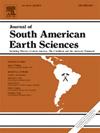Geochemical characterization of phosphate mineralization in quartzite outcrops of the Borborema Province, NE Brazil: potential for utilization with ecological impact mitigation
IF 1.7
4区 地球科学
Q3 GEOSCIENCES, MULTIDISCIPLINARY
引用次数: 0
Abstract
Phosphate is a strategic mineral resource that is essential for agricultural production and global food security. In Brazil, most phosphate production originates from carbonatite complexes, while data on deposits in semiarid regions—such as the Borborema Province—remain limited. This study assesses the potential for sustainable exploitation of phosphate mineralization in quartzite outcrops located in the municipality of Palhano, Ceará. The methodology included the collection of ten representative rock samples for geochemical analysis and the establishment of five 10 × 10 m plots for a phytosociological inventory of the Caatinga vegetation. Major oxides were quantified using X-ray fluorescence (XRF), and trace elements were determined by inductively coupled plasma optical emission spectrometry (ICP-OES). The results revealed heterogeneous phosphate mineralization, with phosphorus pentoxide (P2O5) concentrations ranging from 0.68 % to over 40 %, including high-grade phosphorite samples (>30 % P2O5). The vegetation survey indicated low species richness and a dominance of pioneer species, such as Croton blanchetianus, which are typically associated with disturbed or regenerating environments. Spatial distribution patterns, assessed using the Payandeh Index, confirmed aggregation behavior consistent with ecological degradation. These findings suggest that phosphate extraction in the study area may be viable under sustainable management strategies. The integration of lithogeochemical and ecological data supports informed decision-making aimed at reconciling mineral resource development with biodiversity conservation in environmentally sensitive semiarid landscapes.
巴西东北部Borborema省石英岩露头中磷矿化的地球化学特征:减少生态影响的利用潜力
磷酸盐是一种战略性矿产资源,对农业生产和全球粮食安全至关重要。在巴西,大多数磷酸盐生产来自碳酸盐岩复合体,而半干旱地区(如Borborema省)的矿床数据仍然有限。本研究评估了位于西班牙帕尔哈诺市石英岩露头中磷矿化可持续开发的潜力。该方法包括收集10个具有代表性的岩石样品进行地球化学分析,并建立5个10 × 10 m的样地对Caatinga植被进行植物社会学清查。主要氧化物采用x射线荧光法(XRF)定量,微量元素采用电感耦合等离子体发射光谱法(ICP-OES)测定。结果显示磷矿化呈非均质性,五氧化二磷(P2O5)浓度在0.68% ~ 40%之间,包括高品位磷矿样品(P2O5 > 30%)。植被调查结果显示,该地区物种丰富度较低,以开拓物种(如Croton blanchetianus)为主,通常与受干扰或再生的环境有关。利用Payandeh指数评估的空间分布格局证实了与生态退化相一致的聚集行为。这些发现表明,在可持续管理策略下,研究区域的磷酸盐提取是可行的。岩石地球化学和生态数据的综合支持在环境敏感的半干旱地区协调矿产资源开发与生物多样性保护的知情决策。
本文章由计算机程序翻译,如有差异,请以英文原文为准。
求助全文
约1分钟内获得全文
求助全文
来源期刊

Journal of South American Earth Sciences
地学-地球科学综合
CiteScore
3.70
自引率
22.20%
发文量
364
审稿时长
6-12 weeks
期刊介绍:
Papers must have a regional appeal and should present work of more than local significance. Research papers dealing with the regional geology of South American cratons and mobile belts, within the following research fields:
-Economic geology, metallogenesis and hydrocarbon genesis and reservoirs.
-Geophysics, geochemistry, volcanology, igneous and metamorphic petrology.
-Tectonics, neo- and seismotectonics and geodynamic modeling.
-Geomorphology, geological hazards, environmental geology, climate change in America and Antarctica, and soil research.
-Stratigraphy, sedimentology, structure and basin evolution.
-Paleontology, paleoecology, paleoclimatology and Quaternary geology.
New developments in already established regional projects and new initiatives dealing with the geology of the continent will be summarized and presented on a regular basis. Short notes, discussions, book reviews and conference and workshop reports will also be included when relevant.
 求助内容:
求助内容: 应助结果提醒方式:
应助结果提醒方式:


